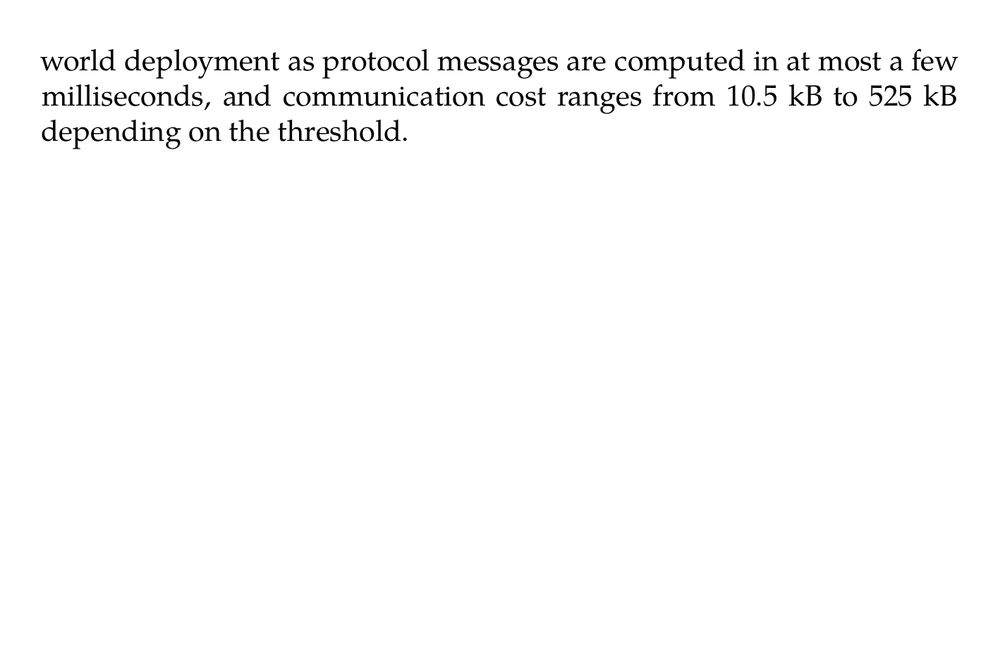This is exactly the setup in this 5-bit experiment: the DL instance is set up in a subgroup of the curve of order 2^5 = 32.
There's a reason we usually pick prime order subgroups.
20.07.2025 19:27 — 👍 0 🔁 0 💬 0 📌 0
Uh... Working in a subgroup of order 32 seems... ill advised. Even with a 256-bit key, if I pick 2^256 as the order of the group I set up my discrete logarithm instance in, Pohlig-Hellman gives a classical attack in 512 guesses max. (256 on average.) No need for a quantum computer here.
20.07.2025 19:27 — 👍 0 🔁 0 💬 1 📌 0
You have 12 usable knuckles on each hand. (Usable because you can point to them nicely with your conveniently opposable thumb.)
29.06.2025 17:08 — 👍 0 🔁 0 💬 1 📌 0

Rosenpass
Build post-quantum-secure VPNs with WireGuard!
This is now also implemented in Rosenpass. (With a more complex PQ key exchange layer.)
rosenpass.eu
28.06.2025 14:24 — 👍 2 🔁 0 💬 0 📌 0
Just in case anyone feels really excited, this closed 10 days ago.
ICYMI... Tough, you missed it.
28.06.2025 14:17 — 👍 0 🔁 0 💬 0 📌 0
Other governments are still (for now) linking government procurement and transition, and generally aligned on adoption. (France likes XMSS, Germany also likes Classic McEliece.)
Also strong signs that other countries are picking up the advocacy piece.
I'm not going to say it so I don't jinx it.
24.06.2025 16:54 — 👍 1 🔁 0 💬 1 📌 0
![Abstract. Threshold signatures enable multiple participants to collaboratively produce a digital signature, ensuring both fault tolerance and decentralization. As we transition to the post-quantum era, lattice-based threshold constructions have emerged as promising candidates. However, existing approaches often struggle to scale efficiently, lack robustness guarantees, or are incompatible with standard schemes — most notably, the NIST-standard ML-DSA. In this work, we explore the design space of Fiat-Shamir-based lattice threshold signatures and introduce the two most practical schemes to date. First, we present an enhanced TRaccoon-based [DKM+24] construction that supports up to 64 participants with identifiable aborts, leveraging novel short secret-sharing techniques to achieve greater scalability than previous state-of-the-art methods. Second — and most importantly — we propose the first practical ML-DSA-compatible threshold signature scheme, supporting up to 6 users. We provide full implementations and benchmarks of our schemes, demonstrating their practicality and efficiency for real-world deployment as protocol messages are computed in at most a few milliseconds, and communication cost ranges from 10.5 kB to 525 kB depending on the threshold.](https://cdn.bsky.app/img/feed_thumbnail/plain/did:plc:fwa55bujvdrwlwlwgqmmxmuf/bafkreig6agg6pu6cl7s65czcnwu7eg74avis272jmcgxlsqokddotarkuy@jpeg)
Abstract. Threshold signatures enable multiple participants to collaboratively produce a digital signature, ensuring both fault tolerance and decentralization. As we transition to the post-quantum era, lattice-based threshold constructions have emerged as promising candidates. However, existing approaches often struggle to scale efficiently, lack robustness guarantees, or are incompatible with standard schemes — most notably, the NIST-standard ML-DSA. In this work, we explore the design space of Fiat-Shamir-based lattice threshold signatures and introduce the two most practical schemes to date. First, we present an enhanced TRaccoon-based [DKM+24] construction that supports up to 64 participants with identifiable aborts, leveraging novel short secret-sharing techniques to achieve greater scalability than previous state-of-the-art methods. Second — and most importantly — we propose the first practical ML-DSA-compatible threshold signature scheme, supporting up to 6 users. We provide full implementations and benchmarks of our schemes, demonstrating their practicality and efficiency for real-world deployment as protocol messages are computed in at most a few milliseconds, and communication cost ranges from 10.5 kB to 525 kB depending on the threshold.

Image showing part 2 of abstract.
Threshold Signatures Reloaded: ML-DSA and Enhanced Raccoon with Identifiable Aborts (Giacomo Borin, Sofía Celi, Rafael del Pino, Thomas Espitau, Guilhem Niot, Thomas Prest) ia.cr/2025/1166
20.06.2025 21:11 — 👍 7 🔁 2 💬 0 📌 1
That is called a cryptographic reduction.
20.06.2025 16:47 — 👍 3 🔁 0 💬 0 📌 0

An emoji, crying with laughter. Heavy tears are streaming down its face, suggesting that it is also crying with crying.
20.06.2025 16:45 — 👍 2 🔁 0 💬 0 📌 0
The joys of the Outlook web client.
18.06.2025 16:28 — 👍 1 🔁 0 💬 1 📌 0
"we are simply moving assumptions to a different level of the stack" is all cryptography has ever been about, though. In the end, it's all about informing risk management decisions and moving risk.
The fact that there's nerdy stuff in the way means we get clever people working on it, which is nice.
14.06.2025 11:17 — 👍 2 🔁 0 💬 0 📌 0
I think you simplified that a bit too far, there...
The article (and its actual title) are very clear that being fluent with multiplication is good, but that the practice of teaching to the test is not.
14.06.2025 10:50 — 👍 0 🔁 0 💬 0 📌 0
A tool that fails safe is more worthy of trust than a tool that fails badly, though. Given that a hybrid KEM is a KEM, I expect it to be made by the tool makers, not by the tool users.
07.06.2025 16:36 — 👍 0 🔁 0 💬 1 📌 0
Sorry I missed it, and happy birthday!
08.05.2025 19:51 — 👍 2 🔁 0 💬 1 📌 0
I might need to start reining in the beard. I look very preacher-y.
Thanks for organising. Looking forward to participate without standing at the front next year :)
04.05.2025 17:24 — 👍 2 🔁 0 💬 1 📌 0
I'd like a lawyer, now.
18.04.2025 09:27 — 👍 1 🔁 0 💬 0 📌 0
I simply read the second "breaking" as in breaking news and temporarily found you extremely clever.
18.04.2025 08:15 — 👍 1 🔁 0 💬 1 📌 0
Sioyek
vim + vimtex (github.com/lervag/vimtex) + sioyek (sioyek.info)
Not sure how good sioyek is on mac.
09.04.2025 21:25 — 👍 2 🔁 1 💬 0 📌 0
Douglas (@douglas.stebila.ca), Cas and Vincent are excellent speakers indeed. Much less sure about that second guy.
03.04.2025 20:13 — 👍 2 🔁 0 💬 0 📌 0
Slush 'za?
21.03.2025 16:55 — 👍 2 🔁 0 💬 1 📌 0
Thank you for your service.
17.03.2025 09:48 — 👍 1 🔁 0 💬 1 📌 0
Sorry to have to miss it. I'll try to make sure I enable Bristol people who are most affected to join.
11.03.2025 17:38 — 👍 1 🔁 0 💬 0 📌 0
"software fixes alone won't protect against hardware-level attacks" should probably be a bit more measured: the software fix shifted the attack from a broad timing channel to a very narrow and noisy power channel that is *a lot* harder to exploit in practice.
25.02.2025 18:59 — 👍 0 🔁 0 💬 0 📌 0
s/ChatGPT/DeepSeek/
08.02.2025 16:58 — 👍 1 🔁 0 💬 0 📌 0
There is no noise, you only need to compute square roots to find preimages, digests are massive.
Why would you need a mathematician or cryptographer to tell you that ChatGPT is not good at designing cryptography?
08.02.2025 16:56 — 👍 2 🔁 0 💬 2 📌 0
Come work with the rather excellent @bedow.bsky.social (and also me)
10.01.2025 17:49 — 👍 8 🔁 2 💬 0 📌 0
![Abstract. Suppose you have a supersingular ℓ-isogeny graph with vertices given by j-invariants defined over 𝔽_(p²), where p = 4 ⋅ f ⋅ ℓ^(e) − 1 and ℓ ≡ 3 (mod 4). We give an explicit parametrization of the maximal orders in B_(p, ∞) appearing as endomorphism rings of the elliptic curves in this graph that are ≤ e steps away from a root vertex with j-invariant 1728. This is the first explicit parametrization of this kind and we believe it will be an aid in better understanding the structure of supersingular ℓ-isogeny graphs that are widely used in cryptography. Our method makes use of the inherent directions in the supersingular isogeny graph induced via Bruhat-Tits trees, as studied in [1]. We also discuss how in future work other interesting use cases, such as ℓ = 2, could benefit from the same methodology.](https://cdn.bsky.app/img/feed_thumbnail/plain/did:plc:fwa55bujvdrwlwlwgqmmxmuf/bafkreifgbrui6i5iqeu5dvou3d2l6cpu7ce2amymv4agkf3erhwpqagxli@jpeg)
Abstract. Suppose you have a supersingular ℓ-isogeny graph with vertices given by j-invariants defined over 𝔽_(p²), where p = 4 ⋅ f ⋅ ℓ^(e) − 1 and ℓ ≡ 3 (mod 4). We give an explicit parametrization of the maximal orders in B_(p, ∞) appearing as endomorphism rings of the elliptic curves in this graph that are ≤ e steps away from a root vertex with j-invariant 1728. This is the first explicit parametrization of this kind and we believe it will be an aid in better understanding the structure of supersingular ℓ-isogeny graphs that are widely used in cryptography. Our method makes use of the inherent directions in the supersingular isogeny graph induced via Bruhat-Tits trees, as studied in [1]. We also discuss how in future work other interesting use cases, such as ℓ = 2, could benefit from the same methodology.
Parametrizing Maximal Orders Along Supersingular ℓ-Isogeny Paths (Laia Amorós, James Clements, Chloe Martindale) ia.cr/2025/033
09.01.2025 15:04 — 👍 1 🔁 1 💬 0 📌 0
UK Crypto Day: 20 February 2025
Schedule
Khanh and Eamonn are organising UK Crypto Day on 20 February at King's College London.
Registration is free (and open) but required: uk-crypto-day.github.io/2025/02/20/u...
Help us spread the word and see you there.
03.01.2025 10:56 — 👍 15 🔁 13 💬 0 📌 1
Thanks for allowing him to contribute.
17.12.2024 17:45 — 👍 1 🔁 0 💬 0 📌 0
@durumcrustulum.com, @sockpuppet.org, @dadrian.io
“Freewheelin’ dynamic”.
https://securitycryptographywhatever.com
https://podcasts.apple.com/us/podcast/feed/id1578405214
Post--Quantum Cryptography Support Action.
Digital Europe project.
Views and opinions expressed are those of the authors only and do not necessarily reflect those of the European Union.
The CISPA Helmholtz Center for Information Security is a German national Big Science Institution within the Helmholtz Association. We research information security in all its facets.
HI! This is an autopost account from @ukri.org. We don't monitor mentions or replies.
The UK’s largest public funder of research
#FundedByYou
The need for independent journalism has never been greater. Become a Guardian supporter https://support.theguardian.com
🇺🇸 Guardian US https://bsky.app/profile/us.theguardian.com
🇦🇺 Guardian Australia https://bsky.app/profile/australia.theguardian.com
Cryptography Researcher at Bergische University Wuppertal. Seeking wisdom, but hasn’t found it yet.
Assistant Prof. for Real-World Cryptography at FAU Erlangen-Nürnberg.
Worked at NYU, TU Darmstadt, and Ruhr Uni Bochum before.
https://roeslpa.de
Tenure-Track Faculty at CISPA • Cryptography & Provable Security
Cryptography professor at the University of Waterloo
https://www.douglas.stebila.ca/
COSIC provides a broad expertise in digital security and strives for innovative security solutions.
COSIC is headed by Bart Preneel.
https://www.esat.kuleuven.be/cosic/
The global authority on PC games. PCGamer.com
America’s Finest News Source. A @globaltetrahedron.bsky.social subsidiary.
Get the paper delivered to your door: membership.theonion.com
Music charity, venue, award-winning music education hub.
https://linktr.ee/BristolBeacon
Independent news website. Only publishes articles written by academics and researchers. No paywall, no ads. #weneedexperts
Sign-up now for our free newsletter: https://theconversation.com/uk/newsletters/
This account is mostly automated.
Senior Lecturer of Cryptography at King's College London.
Professional Protocol Admirer.
Views are my own.
He/Him.
VP / Distinguished Engineer at Amazon Web Services. Also: Open Source and Apache, Cryptography, Irish Music, mediocre Photography.

![Abstract. Threshold signatures enable multiple participants to collaboratively produce a digital signature, ensuring both fault tolerance and decentralization. As we transition to the post-quantum era, lattice-based threshold constructions have emerged as promising candidates. However, existing approaches often struggle to scale efficiently, lack robustness guarantees, or are incompatible with standard schemes — most notably, the NIST-standard ML-DSA. In this work, we explore the design space of Fiat-Shamir-based lattice threshold signatures and introduce the two most practical schemes to date. First, we present an enhanced TRaccoon-based [DKM+24] construction that supports up to 64 participants with identifiable aborts, leveraging novel short secret-sharing techniques to achieve greater scalability than previous state-of-the-art methods. Second — and most importantly — we propose the first practical ML-DSA-compatible threshold signature scheme, supporting up to 6 users. We provide full implementations and benchmarks of our schemes, demonstrating their practicality and efficiency for real-world deployment as protocol messages are computed in at most a few milliseconds, and communication cost ranges from 10.5 kB to 525 kB depending on the threshold.](https://cdn.bsky.app/img/feed_thumbnail/plain/did:plc:fwa55bujvdrwlwlwgqmmxmuf/bafkreig6agg6pu6cl7s65czcnwu7eg74avis272jmcgxlsqokddotarkuy@jpeg)



![Abstract. Suppose you have a supersingular ℓ-isogeny graph with vertices given by j-invariants defined over 𝔽_(p²), where p = 4 ⋅ f ⋅ ℓ^(e) − 1 and ℓ ≡ 3 (mod 4). We give an explicit parametrization of the maximal orders in B_(p, ∞) appearing as endomorphism rings of the elliptic curves in this graph that are ≤ e steps away from a root vertex with j-invariant 1728. This is the first explicit parametrization of this kind and we believe it will be an aid in better understanding the structure of supersingular ℓ-isogeny graphs that are widely used in cryptography. Our method makes use of the inherent directions in the supersingular isogeny graph induced via Bruhat-Tits trees, as studied in [1]. We also discuss how in future work other interesting use cases, such as ℓ = 2, could benefit from the same methodology.](https://cdn.bsky.app/img/feed_thumbnail/plain/did:plc:fwa55bujvdrwlwlwgqmmxmuf/bafkreifgbrui6i5iqeu5dvou3d2l6cpu7ce2amymv4agkf3erhwpqagxli@jpeg)